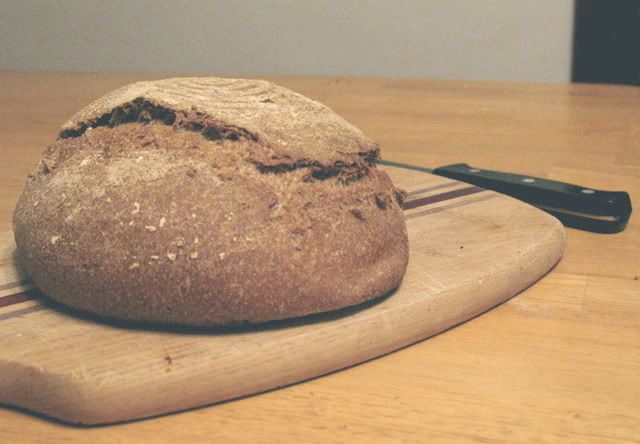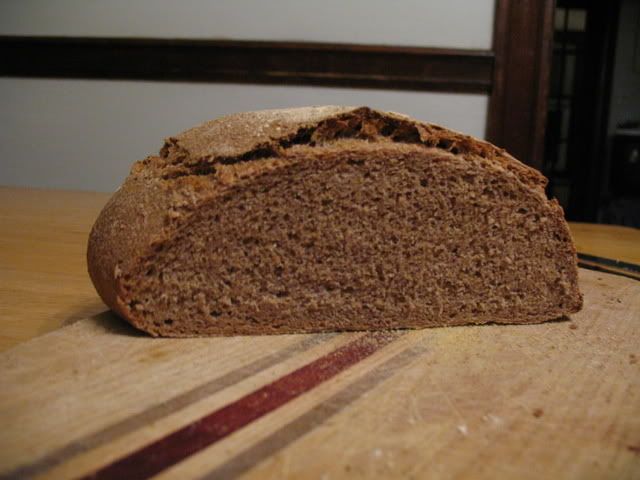
Laurel Robertson, I owe you an apology. I pulled a loaf of Desem bread out of my oven about an hour ago, and, unable to wait any longer, just cut a slice to eat. Without doubt, it is the most delectable, fully flavored whole wheat loaf I have ever eaten. Why it took me this long to get it right, I don't know. But I'm glad I did. When I'm making dinner bread from now on, I'll be making this.
First of all, folks should know that I didn't use a starter made according to the methods described in The Laurel's Kitchen Bread Book
I screwed up my math in preparing the dough, so I ended up with about 38% of the flour as starter rather than the 30% I'd hoped for, but I'm not sure it would make that much difference. You do want a fairly large amount of starter, if I'm reading Laurel's recipe right -- somewhere in the range of about 30%. I also went for the customary 2% salt and aimed at a hydration of 75%.
Here's my formula:
- Whole wheat flour: 100%
- Water: 75%
- Salt: 2%
- 30% of the flour was pre-fermented at 60% hydration.
- 220 grams starter
- 260 grams water
- 320 grams flour
- 8 grams salt
Next, I gave the dough a stretch and fold, let it rest 15 minutes, and then shaped it into a ball. I placed it in a banneton (well-floured) and then used my makeshift proof-box to keep it at roughly 85 degrees for 2.5 hours. At that point, the dough had inreased about 75% in size -- perhaps it even doubled. In any case, I slashed it and put it into my cloche, which had been warming in a preheated, 500 degree F oven for about an hour. I had a slight mishap getting it into the cloche (I was a bit too forceful with the peel, and slammed the loaf into the side of the cloche, turning it over on its side. It mushed it a bit, but nothing serious -- the bake took care of it, mostly. You can see the dent on the bottom right of the loaf above.). I repositioned the bread and covered it. The bake was 30 minutes covered at 500, then 15-17 minutes uncovered at 450. I let it cool for one hour.

As you can see, the crumb does not have the huge holes one expects in white bread (I'm just about convinced that any "whole wheat bread" that has sports huge holes probably consists of at least 50% white flour), but, even so, the bread is not at all heavy or dense. The crumb is light and chewy, with a wonderful crispy crust. The flavor? It's tangy, but not overpoweringly so. There's a buttery undertone, maybe? The flavor lingers long in the mouth after eating. Really, the flavor is tough to describe aside from being complex and delicious.
Like I said, when I have company in the future, this is the bread I'll serve. Utterly delicious.
Well done, Laurel Robertson. And thank you.
- JMonkey's Blog
- Log in or register to post comments
Hi JMonkey,
Congratulations to you although I thought all your WW breads which you have made so far looked spectacular. This one is no different. So I am a little puzzled when you said that this is your first success. Is it the flavor that is different now or the loaf volume?
I made some 100% lean WW not too long ago with 85% hydration but it was just a yeasted version.
http://www.angelfire.com/planet/tomsbread/wholewheat100.htm
I did not follow Laurel's kneading method. Instead, I made the entire dough as a pre-ferment and left it in the fridge for a good 18hours or more. It was left out on the kitchen counter for a couple of hours after mixing. I did 3 rounds S&F before the bake.
The loaf turned out reasonably high and tasted sweet although no sweetener was added, only salt and yeast. It led me to wonder if the key to 100% WW is just sufficient hydration of the bran so that it won't interfere with the gluten network and Desem methods because it has that kind of long soaking needed.
Tomsbread
I've been making whole wheat pan-bread or sandwich bread that I've liked for some time now, but haven't (until now) baked a lean 100% whole wheat bread that I liked. Either the volume was wrong, or the flavor was flat, or the crust was dry ... always something. This bread was finally perfect.
BTW ... wow! Those loaves are spectactular. I've tried 85% before, but the dough always flattened in the oven. I wonder if it was a shaping issue? The crumb you're getting is the most open I've seen from a 100% whole wheat bread.
So how'd you make it again? You mixed the ingredients just until hydrated, let it sit for 3 on the counter and then stuck it the fridge for 18 hours. Did you do the stretch and fold while it was in the fridge or on the counter after the 18-hour cold spell?
Those breads really are remarkable. I'll have to try that.
Hi all! I've just realised from reading JMonkeys fabulous blog that my weekly loaf is in fact a desem loaf.
I bake once a week, more if I'm creating a loaf for a friend or donating to a charity, and this is how I prepare my loaves. I use a starter that is fed with stoneground wholemeal and build the loaf with stoneground wholemeal spelt as well as the stoneground wholemeal wheat flour. At time I have also used stoenground wholemeal Kamut (Egyptian Gold) in the early stage of building the loaf.
Like you I came up with the method to fit in with my schedule and to bring out the flavour of the grain. I understand the concept of cool maturation to bring out the grain's flavour.
It is almost impossible to describe the amazing flavour to folks who have not sampled bread prepared in this way. The flavour has so many aromatic layers and nuances - equally akin to a beautifully crafted wine.
Thanks for sharing because you've shown everyone and managed to convey to all of us what I have been struggling to describe to people for a long time.
Well done!
Cheers Marie
Hi JMonkey,
Here is how I made the 100% ww. The whole idea is to use the entire dough as a pre-ferment. I used 85% hydration because I thought the bran in the ww would need the additional water. A really tiny(less than 1/2 of 1/8 tsp) amount of yeast was added to the 60oz ww flour before I added the water. After the dough had been mixed, it was left on the kitchen counter (temp about 85F) for around 2 hours. The mixing bowl was then covered with cling wrap and left in the fridge for around 18hours. I'd like to believe that this period of time allowed slow fermentation for flavor as well as to give the bran sufficient time to absorb water to soften it suffciently so that it won't 'cut' the gluten strands. ( This is just my hypothesis and I may be dead wrong about all this).
The followng day, the dough is taken out and warmed up for an hour. Salt is added followed by yeast. I normally follow the standard proportions where salt and yeast are concerned ie approx 2 %. I use Himalayan pink salt but don't think it makes much difference.
My way of adding the salt and yeast is a little like folding it in because I use a wooden spoon with a mixing bowl. I like to keep my hands clean until the S&F and shaping. About 30min after the addition of salt and yeast, do the regular S&F, shape, then proof in brotform. I usually proof for an hour. I bake at 210C for around 35-40min with steam at the beginning of the bake of course.
Tomsbread
Wow that's great - I'm glad you think it's worth it and so glad you detailed out your methods here - I'm going to follow them.
I didn't realize you could get away with just feeding the starter for 3 days after converting it from your regular whole wheat starter, I thought it needed more time as a stiff doughball. Mine I think needs more time, because I kept it in my cool root cellar, but with the extra cold weather we've been having, I didn't realize my root cellar temps were getting down to 39F, so the desem was not rising once a day after each feeding. I took it out of the root cellar and left it in the main part of my basement where it is 59F instead, and now it is rising, so I figure I needed to start over feeding it to get it active for a few more days. Maybe I'll be ready to try your formula above by the end of this week.
I know, I know. Laurel wouldn't approve, but I promise I'll have lots of tasty veggies to go with it ....